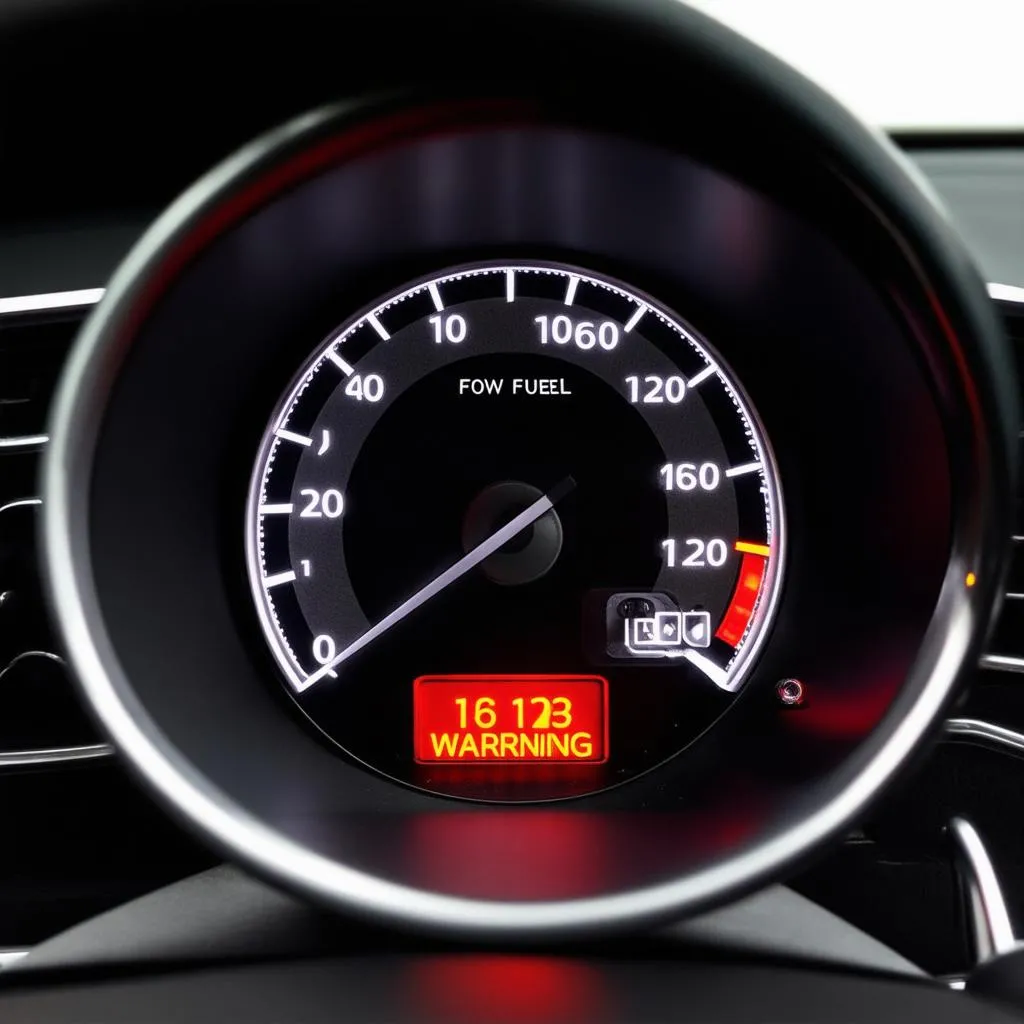Imagine this: You’re cruising down the highway, tunes blasting, feeling good. You glance at your fuel gauge, expecting to see a half-tank, only to find it inexplicably reading empty. Before panic sets in, remember that your car’s computer might just be throwing a tantrum. This scenario is a classic example of the dreaded P0463 OBD-II code rearing its ugly head.
What Does DTC OBD-II Code P0463 Actually Mean?
In a nutshell, the P0463 diagnostic trouble code (DTC) points to an issue with your vehicle’s fuel level sensor circuit. This sensor, often located within the fuel tank, acts like your car’s fuel gauge informant. It constantly measures the fuel level and sends this data to the engine control unit (ECU). When the ECU detects an illogical or impossible reading from the sensor – for instance, your gauge shows empty when you know there’s plenty of gas – it triggers the P0463 code.
This doesn’t necessarily mean you have a sudden leak or your car forgot how much fuel it has (although stranger things have happened). More likely, it indicates a problem with the sensor itself, the wiring connecting it to the ECU, or even a fault within the ECU itself.
Why Should You Care About the P0463 Code?
Beyond the obvious inconvenience of a wonky fuel gauge, ignoring a P0463 code can lead to:
- Inaccurate Fuel Range Estimation: Imagine getting stranded miles from civilization because your car thought it had more fuel than it did.
- Potential Engine Damage: In rare cases, a faulty fuel level sensor can disrupt the fuel-air mixture, potentially harming your engine.
- Failed Emissions Tests: Some emissions tests require a fully functional OBD-II system, and a lingering P0463 code might cause you to fail.
Common Causes of the P0463 Code
Like any good mystery, the P0463 code can have multiple culprits:
- Faulty Fuel Level Sensor: This is often the primary suspect. Sensors can wear out, corrode, or become damaged over time.
- Wiring Problems: Frayed, broken, or corroded wiring between the sensor and the ECU can disrupt the signal, leading to inaccurate readings.
- Fuel Level Sensor Float Arm Issues: Some fuel level sensors utilize a float arm mechanism. If this arm gets stuck or breaks, the sensor won’t function properly.
- Malfunctioning ECU: While less common, a faulty ECU can also trigger this code.
What to Do When You Encounter the P0463 Code
First, don’t panic! Here’s a simple plan of action:
- Verify the Code: While your dashboard warning light might suggest a P0463 code, it’s best to confirm it using an OBD-II scanner.
- Inspect the Fuel Cap: Sometimes, a loose or damaged fuel cap can indirectly cause this code. Ensure it’s tightly sealed.
- Check the Wiring: Visually inspect the wiring harness connected to the fuel level sensor for any visible damage or loose connections.
- Consider Professional Help: If the issue persists, it’s best to consult a qualified mechanic experienced in automotive electrical systems. They can accurately diagnose and address the root cause, whether it’s a faulty sensor, wiring issues, or a problem with the ECU.
The P0463 Code and You: Finding Balance
Interestingly, the P0463 code can be seen through a metaphorical lens as a reminder to maintain balance in our lives. Just as your car needs the right fuel level for optimal performance, we too require balance in various aspects – work, relationships, and personal well-being.
Dr. Helen Palmer, author of “Reclaiming Your Inner Balance,” states, “Ignoring the signs of imbalance, whether in our bodies or our lives, can lead to bigger problems down the road.” This resonates with the importance of addressing the P0463 code promptly to prevent further complications.
 fuel gauge warning light
fuel gauge warning light
Frequently Asked Questions About the P0463 Code
Q: Can I still drive my car with a P0463 code?
A: While you can technically drive with this code, it’s not recommended for extended periods. Inaccurate fuel readings can leave you stranded, and potential underlying issues might worsen without proper attention.
Q: How much does it cost to fix a P0463 code?
A: The cost varies depending on the root cause and labor rates in your area. A simple sensor replacement might be relatively inexpensive, while a faulty ECU could be significantly pricier.
Q: Can I fix the P0463 code myself?
A: If you’re mechanically inclined, you might be able to handle simple tasks like inspecting wiring or replacing the fuel cap. However, diagnosing and repairing the fuel level sensor or ECU often requires specialized tools and expertise.
Other OBD-II Codes Related to Fuel Systems
- P0460 – Fuel Level Sensor Circuit Malfunction
- P0461 – Fuel Level Sensor Circuit Range/Performance Problem
- P0462 – Fuel Level Sensor Circuit Low Input
- P0464 – Fuel Level Sensor Circuit Intermittent
Car Brands Commonly Affected by P0463
While any vehicle with an OBD-II system can experience a P0463 code, some brands have reported this issue more frequently, including:
- Ford
- Chevrolet
- Honda
- Toyota
- Nissan
Explore More Car Care Tips and Advice
- [How to Choose the Right OBD-II Scanner for Your Car](link to relevant article on techcarusa.com)
- [Common Car Problems and How to Troubleshoot Them](link to relevant article on techcarusa.com)
 car wiring harness inspection
car wiring harness inspection
Need Help with Your Car’s Diagnostics?
We understand that dealing with car troubles can be frustrating. If you’re struggling with a P0463 code or any other automotive gremlins, don’t hesitate to reach out. Our team of expert mechanics is available 24/7 to provide guidance and support. Contact us via WhatsApp at +84767531508 – we’re here to help you get back on the road with confidence!
Conclusion
The P0463 OBD-II code, while potentially alarming, is usually a solvable issue. Understanding its causes and taking prompt action can save you from headaches down the road. Remember, knowledge is power when it comes to car maintenance. Stay informed, be proactive, and enjoy the open road!